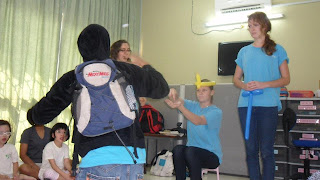What Are Learning Disabilities?
For someone diagnosed with a learning disability, it can seem scary at first. But a learning disability doesn’t have anything to do with a person’s intelligence – after all, such successful people as Walt Disney, Alexander Graham Bell, and Winston Churchill all had learning disabilities.
Learning disabilities are problems that affect the brain’s ability to receive, process, analyze, or store information. These problems can make it difficult for a student to learn as quickly as someone who isn’t affected by learning disabilities. There are many kinds of learning disabilities. Most students affected by learning disabilities have more than one kind. Certain kinds of learning disabilities can interfere with a person’s ability to concentrate or focus and can cause someone’s mind to wander too much. Other learning disabilities can make it difficult for a student to read, write, spell, or solve math problems.
The way our brains process information is extremely complex – it’s no wonder things can get messed up sometimes. Take the simple act of looking at a picture, for example: Our brains not only have to form the lines into an image, they also have to recognize what the image stands for, relate that image to other facts stored in our memories, and then store this new information. It’s the same thing with speech – we have to recognize the words, interpret the meaning, and figure out the significance of the statement to us. Many of these activities take place in separate parts of the brain, and it’s up to our minds to link them all together.
If, like Noah, you’ve been diagnosed with a learning disability, you’re not alone. Nearly four million school-age children and teens have learning disabilities, and at least 20% of them have a type of disorder that makes it difficult to focus.
What Are the Signs of Learning Disabilities?
You can’t tell by looking that a person has a learning disability, which can make learning disabilities hard to diagnose. Learning disabilities typically first show up when a person has difficulty speaking, reading, writing, figuring out a math problem, communicating with a parent, or paying attention in class. Some kids’ learning disabilities are diagnosed in grade school when a parent or a teacher notices a kid can’t follow directions for a game or is struggling to do work he or she should be able to do easily. But other kids develop sophisticated ways of covering up their learning issues, so learning disabilities don’t show up until the teen years when schoolwork – and life – gets more complicated.
Most learning disabilities fall into one of two categories: verbal and nonverbal.
People with verbal learning disabilities have difficulty with words, both spoken and written. The most common and best-known verbal learning disability is
dyslexia, which causes people to have trouble recognizing or processing letters and the sounds associated with them. For this reason, people with dyslexia have trouble with reading and writing tasks or assignments.
Some people with verbal learning disabilities may be able to read or write just fine but they have trouble with other aspects of language. For example, they may be able to sound out a sentence or paragraph perfectly, making them good readers, but they can’t relate to the words in ways that will allow them to make sense of what they’re reading (such as forming a picture of a thing or situation). And some people have trouble with the act of writing as their brains struggle to control the many things that go into it – from moving their hand to form letter shapes to remembering the correct grammar rules involved in writing down a sentence.
People with nonverbal learning disabilities may have difficulty processing what they see. They may have trouble making sense of visual details like numbers on a blackboard. Someone with a nonverbal learning disability may confuse the plus sign with the sign for division, for example. Some abstract concepts like fractions may be difficult to master for people with nonverbal learning disabilities.
A behavioral condition called
attention deficit hyperactivity disorder (ADHD) is often associated with learning disabilities because people with ADHD may also have a hard time focusing enough to learn and study. Students with ADHD are often easily distracted and have trouble concentrating. They may also be excessively active or have trouble controlling their impulses.
What Causes Them?
No one’s exactly sure what causes learning disabilities. But researchers do have some theories as to why they develop. They include:
- Genetic influences. Experts have noticed that learning disabilities tend to run in families and they think that heredity may play a role. However, researchers are still debating whether learning disabilities are, in fact, genetic, or if they show up in families because kids learn and model what their parents do.
- Brain development. Some experts think that learning disabilities can be traced to brain development, both before and after birth. For this reason, problems such as low birth weight, lack of oxygen, or premature birth may have something to do with learning disabilities. Young children who receive head injuries may also be at risk of developing learning disabilities.
- Environmental impacts. Infants and young children are susceptible to environmental toxins (poisons). For example, you may have heard how lead (which may be found in some old homes in the form of lead paint or lead water pipes) is sometimes thought to contribute to learning disabilities. Poor nutrition early in life may also lead to learning disabilities later in life.
How Do You Know If You Have a Learning Disability?
Just because you have trouble studying for a test doesn’t mean you have a learning disability. There are as many learning styles as there are individuals. For example, some people learn by doing and practicing, others learn by listening (such as in class), and others prefer to read material. Some people are just naturally slower readers or learners than others, but they still perform well for their age and abilities. Sometimes, what seems to be a learning disability is simply a delay in development; the person will eventually catch up with – and perhaps even surpass – his or her peers.
But many people with learning disabilities struggle for a long time before someone realizes that there’s a reason they’re having so much trouble learning. For most people in their teen years, the first telltale sign of most learning disabilities occurs when they notice that there’s a disconnect between how much they studied for a test and how well they performed. Or it may just be a feeling a person has that something isn’t right. If you’re worried, don’t hesitate to share your thoughts with a parent or a teacher.
The first step in diagnosing a learning disability is ruling out vision or hearing problems. A person may then work with a psychologist or learning specialist who will use specific tests to help diagnose the disability. Often, these can help pinpoint that person’s learning strengths and weaknesses in addition to revealing a particular learning disability.
Coping With a Learning Disability
Although a diagnosis of a learning disability can feel upsetting, it’s actually the first step in resolving the condition. Once an expert has pinpointed a person’s particular problem, he or she can then follow strategies or take medicines to help cope with the disability. And taking steps to manage the disability can often help restore a student’s self-esteem and confidence.
Some students who have been diagnosed with a learning disability work with a special teacher or tutor for a few hours a week to learn special study skills, note-taking strategies, or organizational techniques that can help them compensate for their learning disability. If you’ve been diagnosed with a learning disability, you may need support just for the subjects that give you the most trouble. Your school may have a special classroom with a teacher who is trained to help students overcome learning problems.
Some schools develop what is called an Individualized Education Program (or IEP), which helps define a person’s learning strengths and weaknesses and make a plan for the learning activities that will help the student do his or her best in school. A student’s IEP might include some regular time with a tutor or in a specialized classroom for a certain subject, or the use of some special equipment to help with learning, such as books on tape or laptop computers for students who have dyslexia.
Medication is often prescribed to help students with ADHD. There are several medicines on the market today to help improve a student’s attention span and ability to focus and to help control impulses and other hyperactive behavior.
There’s no cure for a learning disability. And you don’t outgrow it. But it’s never too late to get help. Most people with learning disabilities learn to adapt to their learning differences, and they learn strategies that help them accomplish their goals and dreams.
(The above article was extracted from one of the posts by Parents Support Group Malaysia Forumer, original author unknown).




































































